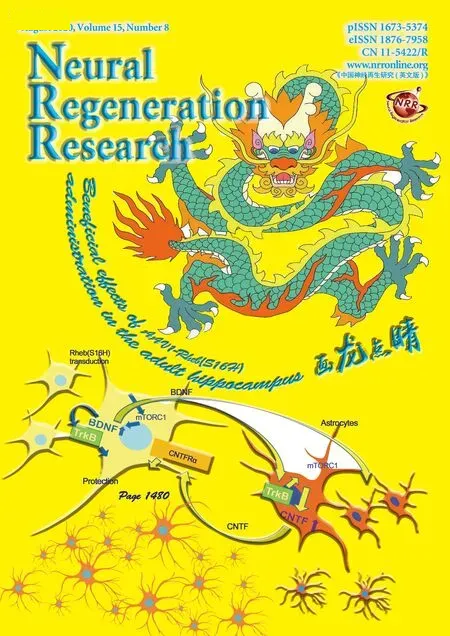中国神经再生研究(英文版)
- Exercise promotes recovery after motoneuron injury via hormonal mechanisms
- Large animal ischemic stroke models: replicating human stroke pathophysiology
- Autophagy and inflammation in ischemic stroke
- Electrical stimulation and denervated muscles after spinal cord injury
- Beneficial effects of saffron (Crocus sativus L.) in ocular pathologies, particularly neurodegenerative retinal diseases
- Toxic tau: structural origins of tau aggregation in Alzheimer’s disease
- Modification of tubular chitosan-based peripheral nerve implants: applications for simple or more complex approaches
- The potential of bone morphogenetic protein 2 as a neurotrophic factor for Parkinson’s disease
- Multimodal treatment for spinal cord injury: a sword of neuroregeneration upon neuromodulation
- The role of cofilin in age-related neuroinflammation
- Role of the metabolism of branched-chain amino acids in the development of Alzheimer’s disease and other metabolic disorders
- LIM kinases in synaptic plasticity and their potential as therapeutic targets
- Rifampicin quinone pretreatment improves neuronal survival by modulating microglia inflammation induced by α-synuclein
- The roles of atypical protein kinase Cs (aPKCs) in the nervous system: targets for neuroregeneration?
- Atypical antipsychotics, more than just an antipsychotic
- Beneficial effects of AAV1-Rheb(S16H) administration in the adult hippocampus
- TET2, an “ambiguous” player in inflammation
- Brain-derived neurotrophic factor mediates macrophage migration inhibitory factor to protect neurons against oxygen-glucose deprivation
- Synaptic development of layer V pyramidal neurons in the prenatal human prefrontal neocortex: a Neurolucida-aided Golgi study
- Enduring alterations in hippocampal astrocytesynaptic proximity following adolescent alcohol exposure: reversal by gabapentin
- Biological characteristics of dynamic expression of nerve regeneration related growth factors in dorsal root ganglia after peripheral nerve injury
- Acupuncture promotes functional recovery after cerebral hemorrhage by upregulating neurotrophic factor expression
- Emotion recognition and inhibitory control in manifest and pre-manifest Huntington’s disease: evidence from a new Stroop task
- Lycium barbarum polysaccharides protects retinal ganglion cells against oxidative stress injury
- Human umbilical cord mesenchymal stem cells to treat spinal cord injury in the early chronic phase: study protocol for a prospective, multicenter, randomized, placebo-controlled, single-blinded clinical trial
- Neuroprotective effect of deferoxamine on erastininduced ferroptosis in primary cortical neurons
- Inhibition of BACE1, the β-secretase implicated in Alzheimer’s disease, by a chondroitin sulfate extract from Sardina pilchardus
- Abnormal brain activity in adolescents with Internet addiction who attempt suicide: an assessment using functional magnetic resonance imaging
- Expression of long non-coding RNAs in complete transection spinal cord injury: a transcriptomic analysis
- Increased thalamocortical connectivity from the affected thalamus to the unaffected hemisphere in a stroke patient

